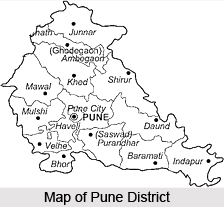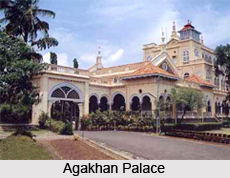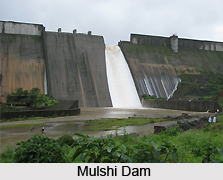 Pune district lies in the western part of the state of Maharashtra. Pune is often known as the `Queen of the Deccan` due to its scenic beauty and rich natural resources. Besides, the district is also famous for its many tourist attractions, especially the historical and religious sites. The city of Pune located here is known on the world map because of its educational, research and development institutions. The district also has importance as an important military base. Pune is the most industrialized district in western Maharashtra and a famous IT hub in the country. The climate of the district shows marked variations due to its geography and topography. Culturally, the district is representative of the typical Marathi culture, with all the traditional lifestyle and food habits. Further details regarding the district of Pune are furnished below.
Pune district lies in the western part of the state of Maharashtra. Pune is often known as the `Queen of the Deccan` due to its scenic beauty and rich natural resources. Besides, the district is also famous for its many tourist attractions, especially the historical and religious sites. The city of Pune located here is known on the world map because of its educational, research and development institutions. The district also has importance as an important military base. Pune is the most industrialized district in western Maharashtra and a famous IT hub in the country. The climate of the district shows marked variations due to its geography and topography. Culturally, the district is representative of the typical Marathi culture, with all the traditional lifestyle and food habits. Further details regarding the district of Pune are furnished below.
Location of Pune District
Pune district is located between the north latitudes of 17 degrees 54 minutes and 10 degrees 24 minutes, and the east longitudes of 73 degrees19 minutes and 75 degrees 10 minutes east longitude. Pune district is bounded by Ahmednagar district on north-east, Solapur district on the south-east, Satara district on the south, Raigad district on the west and Thane district on the north-west. The district has a total geographical area of 15,642 square kilometres which is 5.10 percent of the total geographical area of the state. It is the second largest district in the state of Maharashtra.
Geography of Pune District
 The topography of the district is distributed in a triangular fashion at the foothills of the Sahyadri Mountains. It is divided into three parts: Ghatmatha, Maval and Desh. The district of Pune falls under the tropical monsoon land, and therefore shows quite a marked seasonal variation in temperature as well as rainfall conditions. The climate in the western region of Pune is cool whereas the eastern part remains hot and dry. The hottest months in the district are those of April and May. The maximum temperatures during these months often rise above 36 degree Celsius. The western region of Pune district i.e. the talukas of Junnar, Ambegaon, Khed, Maval, Mulshi and Velha are cool whereas the eastern part i.e. the talukas of Shirur, Daund, Baramati and Indapur are hot and dry. The coolest months are those of January and December, when the average temperature falls as low as 11 degrees. Due to the topography and geographical conditions within the district, the rainfall in the district is rather unevenly distributed. Most of this rain is brought by the southwest monsoon winds. The monsoon arrives in the month of June, with the maximum intensity of rainfall during the month of July and August.
The topography of the district is distributed in a triangular fashion at the foothills of the Sahyadri Mountains. It is divided into three parts: Ghatmatha, Maval and Desh. The district of Pune falls under the tropical monsoon land, and therefore shows quite a marked seasonal variation in temperature as well as rainfall conditions. The climate in the western region of Pune is cool whereas the eastern part remains hot and dry. The hottest months in the district are those of April and May. The maximum temperatures during these months often rise above 36 degree Celsius. The western region of Pune district i.e. the talukas of Junnar, Ambegaon, Khed, Maval, Mulshi and Velha are cool whereas the eastern part i.e. the talukas of Shirur, Daund, Baramati and Indapur are hot and dry. The coolest months are those of January and December, when the average temperature falls as low as 11 degrees. Due to the topography and geographical conditions within the district, the rainfall in the district is rather unevenly distributed. Most of this rain is brought by the southwest monsoon winds. The monsoon arrives in the month of June, with the maximum intensity of rainfall during the month of July and August.
Administration of Pune District
The administration of the district is the responsibility of the District Collector. The Collectorate is headed by the District Collector who is in charge of the Revenue administration within the district and co-ordinates the functioning of all other state Government departments within the district. The office of the Collector has several branches or departments which are supervised by various officers of the rank of Deputy-Collector or Tahsildars. The District Collector is supported by the Additional Collector who looks after certain branches of the Collectorate.
Culture of Pune district
 The culture of the district of Pune is typically Marathi in food, lifestyle and traditions. Education, arts and crafts are given a lot of importance here. A number of famous personalities hail from the district, such as the poet-saint Tukaram, Dynaneshvara, Bal Gangadhar Tilak and Gopal Krishna Gokhale. Pune is also the seat of North Indian Classical Music. Cultural programs like Savai-Gandharva are regularly organised here. Pune is an example of tradition and modernity existing side-by-side. Pune is often called the cultural capital of the Marathi people. All the festivals, like Diwali, Dussehra, Eid, Christmas etc are celebrated here with great enthusiasm.
The culture of the district of Pune is typically Marathi in food, lifestyle and traditions. Education, arts and crafts are given a lot of importance here. A number of famous personalities hail from the district, such as the poet-saint Tukaram, Dynaneshvara, Bal Gangadhar Tilak and Gopal Krishna Gokhale. Pune is also the seat of North Indian Classical Music. Cultural programs like Savai-Gandharva are regularly organised here. Pune is an example of tradition and modernity existing side-by-side. Pune is often called the cultural capital of the Marathi people. All the festivals, like Diwali, Dussehra, Eid, Christmas etc are celebrated here with great enthusiasm.
Tourism in Pune District
Tourism in Pune District has a lot to offer the tourists. Tourism here comprises places of pilgrimage, natural beauty as well as leisure. There are a number of forts located in the district, most of them the achievements of Chatrapti Shivaji Maharaj, the greatest of the Maratha leaders. Apart from this the district has a number of parks, picturesque dams and places of natural beauty and a number of ancient temples which are a must see when visiting the district. The various tourist attractions here include Kasba Ganpati, Ashtavinayak, Sinhagad, Rajgad Fort, Agakhan Palace, Vishram Baug Wada, Katraj Snake Park, Mulshi Dam, Sarasbaug and Peshwa Park and lots more.






